
With the nation blinded by Brexit, it’s easy to lose sight of how varied, fascinating and often beautiful these islands are. So we asked 50 writers to celebrate what’s great about the UK
Isle of Arran
A short sail across the Firth of Clyde on a red-funnelled Caledonian MacBrayne ferry takes me to the wonderful sight of the Isle of Arran, cutting through the water, with Goatfell to the right and Holy Isle just in view off the picturesque village of Lamlash. These are the coordinates of joy, no matter the weather. It’s a place of family holidays, parties, friendship and, for me, creativity. I love to travel the wonderful “String” road – climbing high out of Brodick, over the moors and down into the fertile valley and the beach at Blackwaterfoot, blasting music into the blue cloud-blown sky – eat at the Drift Inn in Lamlash, and walk through the historic gardens at Brodick Castle. I first stayed on the island when I was not two years old and, according to my parents, in the bedroom of the B&B I ripped the wallpaper off the wall beside my cot, much to the landlady’s fury. That was before we had a car, and I was carted around the island on a bike. I go to Arran whenever I can. It was the setting for my first novel, The Legacy of Elizabeth Pringle and on 1 September I’ll be at the Clamjamfry – the arts and music festival named for the Scottish word for a rabble. I’ll speak about eight pieces of art that have inspired me, and I’ll choose them all from the island, chief among them Craigie Aitchison’s luminous and intense paintings of Holy Isle, a place he loved.
Kirsty Wark, Newsnight presenter and Landmark Trust ambassador. Her new novel, The House by the Loch (Two Roads, £16.99), is out on 13 June
Under the Stars festival Barnsley
Pass the ale. Yeah, that woody, chocolatey one. Here comes another pair of dungarees and a rainbow tank top. Lovely. Everything, in fact, is lovely at theUnderneath the Stars festival (2-4 August 2019). Swathed in trees and set amid the rolling hills of Cawthorne, near Barnsley (yes, Barnsley), it’s an enclave of tranquillity. Everyone is polite and considerate and there are no posers or preeners. “Security” is a sweet lady from the WI helping you fasten the entry wristband. So, on your deck chair, pint in hand, you feel safe, at ease, taking a rest from the world, a rest from yourself. And the music? Well, mercifully, it’s not My Dying Bride or Goblin Cock but a cheery amalgam of folkies strumming paeans to revolution, of the serene kind.
Mark Hodkinson, writer and publisher
Durham

Seen from Framwellgate bridge, the ancient city of Durham is the most exhilarating vision of architecture and landscape in England. For architecture historian Nikolaus Pevsner, only Prague and Avignon offered finer views. The castle and cathedral pile into the sky on their promontory, a massive gesture of Norman arrogance after the conquest of the reluctant north. The climb up the medieval street to the castle only reinforces this sense of supremacy. It is the one place in England where we can imagine ourselves back in the middle ages. Within the close, all is monastic survival. The old castle is enlivened by students studying beneath dogtooth arches. The cathedral is overwhelming, softened only by the greenery of the encircling gorge. Its great sandstone walls rest on the hilltop like a recumbent beast. The tower soars over County Durham, as dominant over modern rooftops as it once was over shacks of mud and thatch. The filigree decoration of the west towers is a delightful contrast. Inside, the drum roll of Durham’s famous arcades rams home the message that Normans were here to stay. Small wonder the Saxons capitulated.
Simon Jenkins, Guardian columnist and author
Grainger Market, Newcastle
If cabin fever set in while I was writing my book, I’d escape my Newcastle office and walk to Grainger Market, its cavernous chambers hidden within a city block, behind street-facing shops. Something about the 19th-century market’s arched halls, lit by rows of clerestory windows in the walls above, triggered the dreamer in me. My thoughts would drift from what to write next towards memories of my life in Ireland (I have lived in the north-east for almost six years) before being dragged back to the endless trauma of contemporary British politics. Shops in the market range from English butchers to French crêpe-makers. You can buy Chinese dumplings, Turkish street food and Italian pizza slices. It’s a good place to go and think about how things are, and how they might be.
Karl Whitney, author of Hit Factories: A Journey Through the Industrial Cities of British Pop (Orion, £20), out in June
Denge, Kent
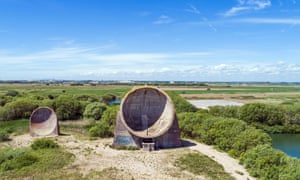
Rising out of the endless shingle landscape like curious monuments from a future civilisation, the “listening ears” at Denge, on the Kent coast near Dungeness, are one of the strangest sights in the country. They poke up above the horizon like gigantic fossilised satellite dishes, isolated on an unreachable island across a moat, making them all the more enticing. These great bowls of concrete were built as an early warning system to detect enemy planes approaching Britain across the Channel. Constructed between 1928 and 1935, they were defunct almost as soon as they were finished. Faster aircraft and the invention of radar before the start of the second world war made them redundant, leaving them as anachronistic relics – and a poetic place of pilgrimage for lovers of concrete ever since.
Oliver Wainwright, Guardian architecture critic
Green Dragon Inn, Hawes, North Yorkshire
The Green Dragon Inn in Hawes, North Yorkshire, is a place that should only exist in the imagination. From the outside, it looks like any old ancient English inn – a lovely place to stop while rambling in the Yorkshire Dales. But the back door is the only access point to a secret and beautiful walk, through fauna and flora ending at a spectacular waterfall that forms the basis of many sweet memories from my childhood.
Meera Sodha, chef, Guardian food writer and author
Wimbledon

The only event that can rival Wimbledon in my affections is Notting Hill Carnival, but I’m going with the former because although they’re both great festivals, there’s no tennis at Carnival. Granted, the costumes are not as much fun and, at the risk of seeming chippy, I cling to the belief that it is impossible to wear a panama hat without looking like a tosser. The Royal Box and debentured seats – aka inherited touting – are stains on England’s green and otherwise pleasant Centre Court, but everything else about Wimbledon – the way the players’ names are not announced as they make their way discreetly on to the courts, the lack of music during end-changes, the all-white rule for competitors’ clothing, the lack of advertising, the emerald glow of the grass, the pervasive conviviality of the crowds – is a source of joy and pride.
Author Geoff Dyer, whose latest book is Broadsword Calling Danny Boy(Penguin £7.99)
Royal Cornwall Museum, Truro
I have lived in Cornwall for nigh on 30 years now, and the place for me that distils all its cliff-edge energy and un-English history is the mineral collection at the Royal Cornwall Museum in Truro. Cornwall is a hotspot of geological diversity: an amazing 14% of the earth’s 400-odd minerals can be found beneath its soil. From the bronze age right up to the industrial revolution, the miners of Cornwall have played their part in shaping the world. But there is nothing functional about the collection of rocks on display in Truro. They are miraculous displays of the earth’s elements, of what happens to copper and tin and iron when they are subjected to intense heat and pressure – the greens of malachite, the yellows of bassetite, the intense blues of azurite and liroconite, the fantasy landscapes of crystals. It is a place to lose yourself in wonder.
Philip Marsden, whose new book, The Summer Isles: A Sea Voyage (Granta, price tbc), is out in October
The Forth Bridge
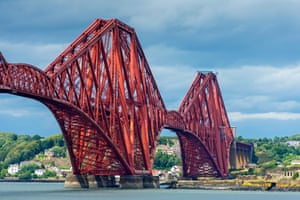
In my palm, a talisman: a brittle dome the colour of dried blood. It’s paint, flaked off the Forth Bridge, formed around a rivet – one of 6.5 million – during unending repaintings. This ghost rivet, which I found one day while on the bridge for work, brings to mind the entire structure – 2,467 metres of it stretching from Lothian to Fife. The bridge has stood in the firth since 1890, and stands for how we in Scotland like to see ourselves: strong, ingenious, a pragmatic grace weatherproofing us against life’s winds and tides. It – she – is beautiful. Look at her psychedelic geometry. Look at her unyielding span. Put her on a tea towel and she loses no dignity, transcends kitsch. I love her beckoning steel.
Peter Ross, author of The Passion Of Harry Bingo (Sandstone Press, £8.99)
Northallerton Station Hotel, North Yorkshire
It may look like any old Victorian pub, serving big fried breakfasts and Sunday lunch, but the Station, with its roasting log fire and quirky teapot collection, embodies a particular warmth. A few pounds buys a giant pot of Yorkshire tea and a plate of cake: perfectly gooey homemade brownies or ginger parkin from Whitby. The Cleveland Way, a beautiful, looping, long-distance route across the North York Moors, is a 20-minute bus ride from Northallerton. The path was knee deep in snow early last year, with black grouse chirring out of the white-muffled heather. Our spectacular hike ended back at the Station, with our soaked socks steaming warmly by the fire as we waited for the train.
Phoebe Taplin, whose latest book is Walk York (Pitkin, £6)
Holkham beach, Norfolk

There is something very British about a beach that is at its most beautiful in bad weather. Idyllic under blue summer skies, the four miles of pale golden sand at Holkham in north Norfolk, reached through a dense brow of pine forest, is heart-melting under a silver frost and thrilling when a storm rolls in and turns sky and sea to pewter. Horizontal lines bring a sense of calm, a slowing of the breath, and this is just as true of these epic stretches of shore, horizon and treeline as it is of impressionist landscapes, or Ingres nudes. Turn left at the end of Holkham gap, walk to the hollowed out dune mountain of Gun Hill (used as an artillary emplacement in the Napoleonic Wars), then turn left again and head inland along the raised bank to Burnham Overy Staithe. Breathe. Go for a pint in the Hero. Perfect.
Jess Cartner-Morley, Guardian associate fashion editor
The Peer Hat, Manchester
In a city where Factory Records’ legacy is exploited by the same property developers who are rapidly pricing any creativity out of the city centre, the Peer Hat – a pub, grassroots music/arts venue and DIY record shop – has, in 18 months, come to feel like a much-loved last stand … a persistent weed amid all that new concrete and glass. Hidden on a Northern Quarter side street where stag dos fear to tread (and so shambolic they wouldn’t stay long anyway), the Hat has a gloriously random, lo-fi events programme, clearly done for love not money, giving it a friendly, all-comers community feel that is far closer to the dissenting spirit of late-1980s Manchester than any Hacienda revival night. It is an oasis of odd in an increasingly bland city.
Tony Naylor, Manchester-based Guardian journalist
Broadstairs, Kent
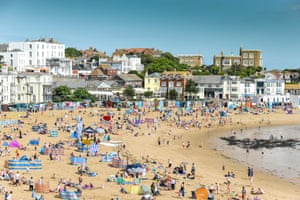
Clinging on to the south-eastern tip of Britain, wedged between the rapidly gentrifying Georgian seaside gems of Margate and Ramsgate, Broadstairs feels like the town that time forgot. My dad used to holiday there in the 1950s, and though their hotel is now (luxury) flats, his favourite ice-cream parlour, Morelli’s, is still serving the knickerbocker glories he was never allowed (and dog ice-cream, too, these days). At low tide you can walk along the coast from Margate, beneath crumbling wartime fortifications, the 78 steps cut in the chalk that inspired John Buchan’s 39, and the original Bleak House, with views across to France on a clear day. Away from the centre, the beaches are always gloriously empty apart from the occasional abalone hunter: what a way to work up an appetite.
Felicity Cloake, food writer
St Wystan’s crypt, Repton, Derbyshire
The Anglo-Saxon crypt at St Wystan’s church was built – unbelievably – in the early eighth century and is the burial place of the kings of Mercia. This is a building so hallowed and ancient you feel you should approach through swirling mists with ravens cawing overhead. Half-buried beneath the church, the crypt is a small, vaulted chamber, thick with carved stone columns and recesses for bones. In 873 the great Viking army over-wintered here and buried their fallen warriors in the surrounding fields. The crypt was not rediscovered until a grave digger crashed through the vault in 1779. It seems almost impossible it should survive, and to stand silently on its medieval flagstones is to be borne back to the age of Bede.
Dr Anna Keay, director, the Landmark Trust
Suilven mountain, Sutherland
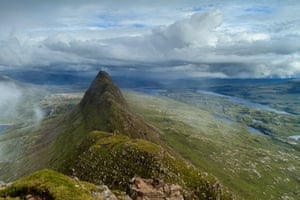
In the north-west of Scotland lies Assynt, an otherworldly landscape of barren scrub and glacier-carved mountains. Suilven, the most famous of these, has mesmerised artists from Norman MacCaig to electronic band Finiflex. It takes seven hours, on a good day, to walk in, up and back. It is not for the faint-hearted – at the base is half an hour of bog, the ascent is near-vertical, and the ridge is around a metre wide. From the top, on a good day, you can see for miles, a landscape of sapphire lochs and vertiginous peaks. A pair of golden eagles nest near the summit and hover, menacingly, just above. On a bad day you won’t see your hand in front of your face and should not even attempt to climb this mountain.
Rosamund West, editor-in-chief of culture magazine The Skinny
Pier Art Centre, Orkney
I first walked into the Pier Art Centre (PAC) in the summer of 1979, when I was 13. The gallery had just opened and my Granny wanted to “tak a keek”. She told me a woman, a peace activist from London called Margaret Gardiner, had left 67 of her paintings to the people of Orkney. I thought that was a grand idea. On holiday I mixed working on the croft and taking in peat with seeing the art of incredible women artists such as Barbara Hepworth, Margaret Mellis, Sylvia Wishart and Margaret Tait. Some 40 years on, PAC is the heart of the island’s artistic community, a contemporary gallery and museum valued by artists, academics and visitors from across the world. A precious thing indeed. And with a beautiful shop.
Sarah Munro, director of the Baltic Centre for Contemporary Art in Gateshead
Deal pier, Kent
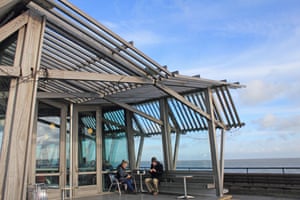
I love piers: with infinite ease, they take you out to sea, immersed in the wind and surrounded by clouds. I also have a soft spot for cafes: I write best when surrounded by movement. So it was with great delight that I heard a new cafe, Deal Pier Kitchen, was opening at the end of my local pier. Where better to write about tides than in a cafe surrounded by water? The pier itself – a brutal slab of concrete-clad steel built in the 1950s – could hardly be called attractive, but the building at its end, Deal Pier Kitchen, hovering over the waves, is an architectural wonder. Built in timber, wrapped in glass and held together with marine-grade stainless steel, it is a joy to spend time in. And I spend a lot of time there now, perhaps too much, fuelled by coffee and writing about a natural world that is so entwined with this magical place.
William Thomson, author of Tides and the Ocean (Black Dog and Leventhal, £21)
Buckland-in-the-Moor, Devon
On a wooded slope on the edge of Dartmoor, reached by a tortuous, winding lane, lies Buckland-in-the-Moor, a pretty hamlet of a few thatched cottages, manor house, farm and little flint church. Above it is a high granite tor with a huge split rock on which the Ten Commandments are carved (commisisoned by the lord of Buckland Manor in 1928); the River Dart rushes white through dense woods in the valley below. We stayed in Buckland every summer all through my childhood, renting what was once the hamlet’s tiny stone school. It hasn’t changed a great deal since then, and to me retains the luminosity of a lost paradise – perhaps because, as it’s not on the way to anywhere, the only visitors are those who seek out this tiny Domesday settlement.
Melissa Harrison, whose latest novel is All Among the Barley (Bloomsbury, £8.99)
Chalice Well, Glastonbury
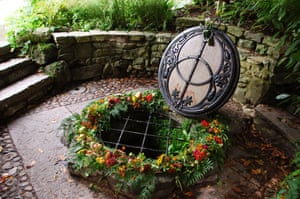
At the base of Glastonbury Tor, Chalice Well is one of the most famous in the world and steeped in mystery and legend. A natural spring fed by an aquifer, it has been in use for around 2,000 years, unfailingly delivering a million litres of water a day at a steady 11C. This constancy, and the water’s reddish hue (from its iron oxide content), make the spring special, but when these elements are combined with Christian and Arthurian myths, they gain even greater potency. Christian legend has it that after the crucifixion, Joseph of Arimathea, a secret disciple, came to Glastonbury with the Holy Grail (the chalice Christ used at the Last Supper and which caught drops of blood at his crucifixion). He placed the chalice under the well, which supposedly turned the water blood-red. The chalice was later sought by King Arthur’s knights and is central to the Arthurian legends of the Isle of Avalon (so named because the Tor was once surrounded by sea).
Clare Gogerty, author of Beyond the Footpath: Mindful Adventures for Modern Pilgrims (Piatkus, £14.99)
Stoney Littleton Long Barrow, Somerset
Set above pretty Wellow village and overlooking rolling Somerset fields, Stoney Littleton is one of Britain’s best examples of a Neolithic chambered long barrow. Open to all and free to enter, it is, strangely, always deserted but for our gaggle of friends and children. Crawling into the stone tomb, we explore the seven chambers by candlelight. Crouching on the damp earth, no one can ignore the unique sense of ancient history and sacredness this place holds. Imaginations often run riot, the subterranean deep peace broken by the strange ritual games children can’t help but play. Emerging back into the light, we climb the grassy cover and lie down among the wild flowers, contemplating the prehistoric lives of the early farmers who built this shrine over 5,000 years ago.
Tania Pascoe, author of the Wild Guide to South West England, (Wild Things Publishing, £16.99)
River Sprint, Cumbria
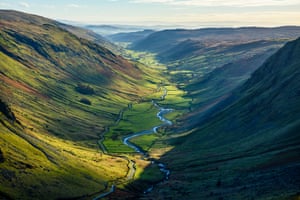
Deep in a woodland seam, at the edge of an elegant slantwise waterfall, my favourite footpath passes a rocky promontory in the River Sprint, much like a Victorian viewing station. It’s a place to pause and contemplate England’s shortest river as it races downstream. The path follows the old mill race then opens into a clearing where the wild merges into flower gardens above a sinuous twist in the river. Here are the restored historic buildings of Sprint Mill, a place that frequently calls me back to sit awhile and drop away from the everyday, to watch blackbirds surf the woodland understory and dippers unzip the water. Beyond lie meadows where curlews call.
Karen Lloyd, author of The Blackbird Diaries (Saraband, £12.99)
Leeds City Museum
Built in 1819 to provide education for the city’s industrial workers, Leeds City Museum is now a vibrant hub for hundreds of community events; a fantastic place to spend a few hours with the Leeds Mummy; or discover something new on your lunch break. It is an inclusive space for the whole city, with great cake. The summer Leeds Pride parade starts outside the museum. This year it’s on 4 August, when thousands of people will watch over 120 floats in a joyous and proud celebration of the city’s LGBT community. The Trans Pride Leeds march starts at the museum at 11.30am on Sunday 31 March 2019.
Alexandra McEwan-Hannant, director, Leeds Pride
Dungeness, Kent
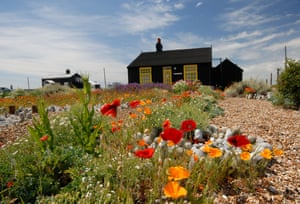
I first visited this shingle headland sticking out into the Channel, close to the border of Kent and East Sussex, on a blindingly sunny day: a heavy blue sky weighing down on the flat land added to the strangeness of the place. Dwellings are scattered about, including several squat, rubber-covered buildings and peeling wooden shacks. The famous shingle garden of the late film director Derek Jarman maintains its peculiar mix of wild poppies and purple valerian. In a tiny art gallery spread across three garden sheds, I read aloud a sign that said, “Dungeness is not bleak.” A disembodied voice echoed this from a nearby garden: “Don’t call it bleak!” So not bleak, then, but about as close to a wild west as the UK gets.
Hazel Sheffield, founder of Far Nearer, which maps community projects
The George Inn, Southwark, London
For years I’ve stopped at the George for a drink while in the area. Built in 1677 as a coaching inn, the Grade I-listed building (owned by the National Trust) is the only London galleried pub still in existence. Charles Dickens drank here, perhaps under the 1797 clock in the Parliament Bar. The pub is a reassuring constant in an ever-modernising neighbourhood. The Shard and Guy’s Hospital tower over the courtyard, but by the cosy fireplace, enveloped by dark timber-framed walls and wonky beamed ceiling, you feel immersed in old London.
Noo Saro-Wiwa, author of Looking for Transwonderland: Travels in Nigeria(Granta, £9.99)
Bridport, Dorset

Gateway to the Jurassic Coast and once the centre of the country’s rope- and net-making industries, Bridport is guarded by Eggardon Hill, an iron age hill fort with spectacular views across the town to the sea and Colmers Hill, with its copse of Scots pines commemorating those lost in the first world war. Now a hub for writers and artists, Bridport (check out the vintage market twice weekly) was the inspiration for Port Bredy in Thomas Hardy’s The Mayor of Casterbridge, and for artists such as Augustus John, Paul Nash and Edward Ravilious, whose work reflects the Dorset coast and landscape. Annual festivals abound, celebrating agriculture, art, cider, film, folk, food, literature – and hats. The pace of life is gentle – the town hall clock runs slow – offering everyone time to dawdle and discuss the day’s events and tomorrow’s weather.
Tanya Bruce-Lockhart, director, Bridport Literary Festival
River Taff, Brecon Beacons
Superficially, a river’s source is only where its above-ground life begins; it is humans that lend it romance. The source of the Taff is off Pen Y Fan’s summit. Part of my story began with the Taff, so its tiny source is for me an important place to sit and reflect. That river pulled my first book out of me, and a BBC series. I caught my first salmon there, and found the person I love. “If you stretch your fingertips you can actually feel the river trickle out of the mountain.” That’s what I said to her one sunny afternoon, waiting on one knee till she found the ring in the source’s mossy hollow.
Will Millard, author of The Old Man and the Sand Eel (Penguin, £14.99)
The Roaches, Peak District

A jumble of geological majesty, the soaring outcrop of gritstone known as the Roaches is a wild gem within an hour’s drive of the Potteries and Manchester. Along with similarly spectacular neighbouring outcrop Hen Cloud, they form a magnet for climbers and walkers. Peregrine falcons and ground-nesting birds return every spring; royal purple carpets of heather explode on the surrounding moors every August; and there are breathtaking views all year round into the heart of England. The cave dwelling that’s now the Don Whillans Memorial Hut is a sight to behold. British Mountaineering Council members can stay in it overnight, using it as a base to go climbing – it’s nestled into the rock itself.
Lynn Robinson, president, British Mountaineering Council
Sloans Bar and Restaurant, Glasgow
This bar and restaurant over three floors is a hidden beauty, has that comforting, dark wood-panelled feel to it, and is always busy with classic Glaswegian characters. It’s the perfect place to while away hours putting the world to rights or rowing about politics – I spent a good few nights there during the Scottish independence referendum campaign in 2014. But my fondest memories are seeking refuge there on Christmas Eve. I was brought up in Glasgow and my family still live there. After my usual last-minute, high-stress, present-buying panic, catching up with my old school pals is a great festive tradition. They also do a fabulous cullen skink, the thick soup of smoked haddock, potatoes and onions.
Ayesha Hazarika, political commentator and comedian
St Fagans National Museum of History, Cardiff
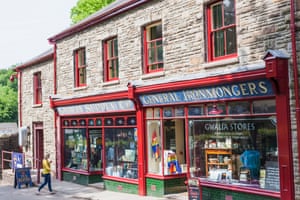
I didn’t visit St Fagans until I was an adult. We didn’t have a car to travel to the other side of Cardiff from the council estate where we lived. It was the UK’s first open-air museum, with over 40 buildings moved from their original sites and rebuilt brick by brick across the museum grounds. It holds different eras of Welsh architecture, including a long house, a non-conformist chapel, a workers’ institute, and 19th-century workers’ cottages. I was the artist-in-residence in 2017-18 and being there on an early misty morning felt like having access to time travel. We now visit regularly – there’s a farm, part of the original site, and my daughter loves to see the piglets. Thanks to public funding, it is still free for all.
Sean Edwards, artist representing Wales in this year’s Venice Biennale
Devenish, County Fermanagh
It has no high crags or swooping slopes, but what Northern Ireland’s lake district lacks in drama it makes up for in quiet beauty and a strange, resonant history. The twin lakes of Lower and Upper Lough Erne were once home to many monastic settlements scattered across their hundreds of tiny islands, and a short boat trip from Enniskillen leads to Devenish, a low island which first housed a monastery in the sixth century. None of those buildings remains, but a round tower, built in the 12th century, does, along with evocative ruins of other buildings and a beautifully carved medieval stone cross (though pretty newfangled by Irish standards). The saints are long gone, but the echo of their presence is powerfully felt here.
Esther Addley, senior Guardian news writer
Little Moreton Hall, Cheshire

I remember it clearly. We were in front of the vast kitchen hearth, and the lady tour guide offered the kids in the group a challenge – in Tudor times, it was the children’s job to fetch water using the large iron pot at her feet. Did we think we could do it? Normally reticent, I stepped forward that day. Like a mini Jeff Capes I hefted the bucket and marched it across the smoky stone-flagged floor. I felt the thrill of lived history – not dusty book-learned, but visceral. Little Moreton Hall is a beautiful, ornately half-timbered 500-year-old manor house. It’s higgledy-piggeldy, has tiny, bent windows and funny odd-angle corners. It’s a place for adventures and imagination, gloriously old but still very much alive.
Mary-Ann Ochota, author of Hidden Histories: a Spotter’s Guide to the British Landscape (Frances Lincoln, £14.95)
Cycling South Head, Peak District
Kinder Scout gets all the glory, but for me South Head is the best Peak District hill. You can walk it, but I like to ride up it on my mountain bike, ascending from Chinley, which has a station with connections to Sheffield and Manchester, and a corking cycle-friendly pub, the Old Hall Inn. The single-track road stops at my dream home, Beet Farm, and then turns into a gravelly bridleway. It is a tough climb but worth every drop of sweat for the view at the top of the bridleway, which boasts Kinder to the right and Mount Famine to the left. Then it’s a fun descent into Hayfield for lunch. Rosie Lee’s tearoom does the best grilled cheese sandwiches and they don’t mind muddy bums.
Helen Pidd, North of England editor
Joseph Wright of Derby masterpiece

It’s a painting about wonder, and a wonder of British art. Joseph Wright of Derby’s 1766 masterpiece, A Philosopher Lecturing on the Orrery, portrays faces glowing in the golden light of a lamp that’s set at the heart of a clockwork model of the solar system. This was the closest you could get to space travel in the 18th century, an interplanetary journey of the mind. It’s not just light but discovery that brightens the eyes of the children gazing at the orbiting planets. Wright was part of a group of Midlands intellectuals and industrialists at the cutting edge of the Enlightenment, so it’s fitting that his vision hangs in Derby Museum, free for all to enjoy. Forget stately homes – this is a real British treasure.
Jonathan Jones, Guardian art critic
Silloth, Cumbria
I first rolled into the isolated little town of Silloth 10 years ago, when cycling down the Cumbrian coast, and was captivated by the sheer scale and unexpectedness of it: the cobbled main street, wide enough to host a military parade of tanks and rocket launchers; the beautiful three-storey Victorian terraces, painted in pastel and primary, overlooking a 36-acre green, complete with rose garden and pagoda, that runs down to the Solway Firth, beyond which loom the hills of Galloway; the little ice-cream shops and tearooms. It felt like a town built for a future that never came. Except it had done, briefly, in the 19th century, when the railway arrived and, with it, hordes of trippers from Carlisle. Tastes changed. The line was axed. Silloth, its name straight from a Brönte novel, should have rotted. But it didn’t, somehow, miraculously; a community determined that it wouldn’t. I have friends in the Lakes and visit Silloth most years now. There are never crowds. I walk along the long promenade, looking for the famous Solway porpoises, and am always happy there.
Mike Carter, author of All Together Now? One Man’s Walk in Search of His Father and a Lost England (Guardian Faber, £9.99)
Rùm Cuillin
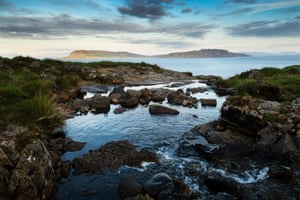
For three nights in the year 1014, a Viking fleet anchored off the Isle of Man was attacked by clamorous “iron-billed ravens”. This was an early encounter with Manx shearwaters returning to their colony, and the origin of the first half of the birds’ name. So says the excellent pamphlet produced by Scottish Natural Heritage on the UK’s largest colony of Manx shearwaters, estimated at 100,000 pairs on the mountainous Isle of Rùm. This is a smaller, lesser-known Cuillin ridge than the one on the Isle of Skye. Setting off early from Kinloch, I entertained myself on the ridge’s flakes, cracks and spikey spines. As you tumble down from Sgùrr nan Gillean (young lads’ peak), you stumble on the bothy at Dibidil. It’s a classic stone-built, corrugated-roofed cottage with two large fireplaces, kitchen table, candles and comfy if hard pallet-style beds. It is wood-lined, antler-adorned and its small windows offer views towards the Isle of Eigg.
Murdo MacLeod, photographer
Ramsgate Music Hall, Kent
This small, 140-capacity venue routinely entices big-name artists to the Kent coast – among them Jarvis Cocker, Four Tet, Gruff Rhys, Neneh Cherry, Cate Le Bon and Sleaford Mods. It’s easy to see why: the sound is impeccable, the beer local and the atmosphere quite magical. It also offers film nights, club nights, a radio station and a membership programme. Like the Trades Club in Hebden Bridge and the Prince Albert in Stroud, it plays a vital role in the local community, nurturing the area’s new talent, and forming the exuberant heart of a small, slightly out-of-the-way town that dearly loves music.
Laura Barton, music journalist
St Pancras International station, London
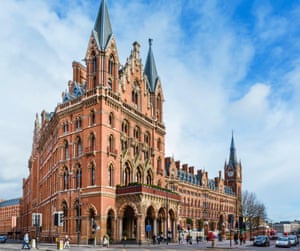
This sprawling vision of Victorian Gothic architecture is one of the most beautiful railway stations in the world. More like a cathedral or a fortress, the red-brick beauty only appeared on my radar after I’d spent time travelling in and out of Mumbai’s Chhatrapati Shivaji Maharaj terminus and realised it was modelled on St Pancras. Opened in 1868, St Pancras was built to connect London with England’s major cities and deliberately designed to impress. Now the gateway to Europe and the rest of the railway world, the station holds a special place in my heart: it was where I began my rail journey around the world, looking up at the iron ribcage arched across the roof and the last of the London sunshine blazing between its bones.
Monisha Rajesh, author of Around The World in 80 Trains (Bloomsbury, £20)
Walla Crag, Cumbria
This landscape was my playground. So much of my youth was spent climbing on the local crags, flying my paraglider above this fell and windsurfing on the lake below. On first sight, this easily accessible hike seems an unlikely place to explore. But it’s not hard to venture off-route and discover hidden sections nestled between fell tops. The summit of Walla Crag offers stunning views across the Northern Fells. I’d recommend you head back via the lovely Ashness Wood to the shores of Derwentwater and a boat ride or lake shore walk back to Keswick.
Steve Scott, director, Kendal Mountain Festival
New Brighton, Merseyside

It’s fanciful to suggest that Liverpool has a South Bank, a Brooklyn or even a Christiania – an over-the-water, sketchy decompression zone. But if it happens, it’ll happen in New Brighton. I love this square mile of spunky seaside resort on the northern tip of the Wirral peninsula. Once a seething mass of Scouse summer day trippers and Martin Parr photo opportunities, it’s crackling with energy again. Saturday acoustic sessions at the Sea Shantycoffee shop, and a stroll around the cafes (the breakfasts at Remember Whencafe on Victoria Parade are excellent) and the bars of the spruced-up Victorian Quarter reveal a town with a renewed sense of purpose: cool creatives, candy floss and Count Arthur Strong at the Floral Pavilion. Perfect. If the Coral can rise again, so can New Brighton.
David Lloyd, co-founder of Liverpool-based creative agency Kindholm
The Camel Trail, Cornwall
The Camel estuary is where my wife and I first holidayed together. We bundled our tandem off the train at Bodmin Parkway and soon hit greenery. No traffic, just gravel crunching under tyres. Then more sky than trees as the sheltered Camel Trail turned into a snaking golden ribbon and the estuary opened out in front of us, wide and bright. As we glided across steel bridges that once carried trains, it was all ours. Later, when we retraced our tracks from Padstow, it was for everyone. People sauntering, cycling, pushing children, sharing space, the breeze and that light. We’ve been back with our girls and it’s still special: a place where sea meets river meets land, and an old railway line has been turned into a path for everyone.
Xavier Brice, CEO, Sustrans walking and cycling charity
Cadair Idris mountain, Snowdonia
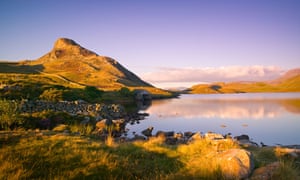
I’m not sure how or why Cadair Idris became our family’s favourite mountain. When they were small, my children were convinced that King Arthur was buried under it, which did lure them back in case he appeared. It’s actually a great peak for little legs: it looks huge and daunting, but is only 893 metres high and a four-mile round trip at its shortest. The top in winter can deliver a taste of the Arctic: we once turned back because the wind was too much. The stone hut on the summit is a welcome shelter sometimes, but usually we’ve had glorious sunshine and views of the Irish Sea. The main “pony path” starts a couple of miles south-west of Dolgellau (stock up on supplies here), but my favourite route is from Minffordd in the south: it’s a bit more spectacular. Wild swimmers will need to tackle the scree slope down from the top (I wouldn’t fancy ascending that way) to Gadair tarn. It’s a pocket battleship of a mountain, full of surprises.
Kevin Rushby, Guardian Travel writer
Islands of Fleet, Galloway
The tiny Islands of Fleet are hidden in Scotland’s far south-west, rather than the hoaching north-west, on the less-travelled Solway coast near Gatehouse. Unless you have your own boat, you can only look at them lying enticingly offshore. I discovered this timeless littoral by accident after stocking up on ice-cream and delicious cheese from the Cream O’Galloway farm nearby. I followed a track by some cabins in a community called Carrick. I found coves to swim in and rocky bluffs from which to watch the sunset, the islets you can never quite get to bathed in the limpid Solway light, both forgotten and unforgettable.
Pete Irvine, author of Scotland The Best (HarperCollins, £15.99)
Valhalla Museum, Tresco, Isles of Scilly
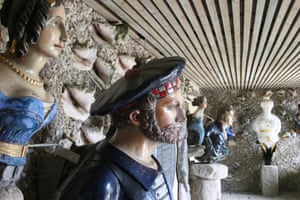
The first time Newlyn School of Art ran a painting holiday in the Scillies, our young family rented a cottage so I could oversee it. I will never forget stumbling on the Valhalla Museum at the Abbey Gardens. It is the most emotive, tragic and romantic memorial to the many shipping disasters that have taken place in the treacherous waters around Scilly. One that sticks in my mind is the Primos, whose sole survivor was found clinging to the ship’s figurehead. The museum has around 30 figureheads, packed together so you feel like you are walking around the sailors, merchants and civilians who perished in these disasters. The adventure of travelling to Tresco via a tiny plane and a small boat, followed by a tractor ride to our cottage, was all part of the magic.
Henry Garfit, director, Newlyn School of Art, Cornwall
Water of Leith walkway, Edinburgh
My favourite footpath in the world is the Water of Leith walkway (it is also a cycleway). Starting in Balerno, at the foot of the Pentland hills south-west of the city, it follows the river for 12½ miles to the port of Leith. Surrounded by woodland, it’s a green ribbon of calm through the heart of the city. It can be tackled in different sections – my personal favourite is from Stockbridge to Dean Village, where highlights include the village of Stockbridge itself, with its elegant Georgian and Victorian terraced houses, the circular Roman temple of St Bernard’s Well, and ridiculously beautiful Dean Village, with its half-timbered houses. Coming here feels like a walk back in time.
Kash Bhattacharya, founder, Budget Traveller website
Wormwood Scrubs, London

I am in love with a place that is so unremarkable that my birdy friends initially thought I had lost my mind. The place is Wormwood Scrubs. It’s a 183-acre park that adjoins the prison of the same name and was featured lyrically in the Jam’s single, Down at the Tube Station at Midnight. I discovered early on that the Scrubs attracts an amazing variety of birds, some of them nationally rare. It is also the venue where I first realised that by simply looking up you could see a lot. Misty early mornings are magical here. It’s so wild that I often imagine myself alone in the countryside – in urban west London.
David Lindo, author of How To Be An Urban Birder, theurbanbirder.com
The Church of St Mary the Virgin, Capel-y-ffin, Black Mountains
The church dates from 1762 but the site, below Gospel Pass at the head of the Llanthony valley, has been a spiritual retreat for centuries. It is said a vision of the Virgin Mary appeared here in Norman times. The tiny whitewashed building with its wobbly belfry is just eight metres by four inside. The plain glass window, looking up the steep valley to heather moorland, is etched with a line from Psalm 121: “I shall lift up mine eyes to the hills whence cometh my salvation.” In the graveyard, encircled by ancient purple-barked yews, are two headstones engraved by sculptor Eric Gill. Walk the surrounding hills to experience a tranquillity that lured Francis Kilvert, Eric Ravilious, David Jones and Bruce Chatwin here.
Rob Penn, author of The Man Who Made Things Out of Trees (Particular, £16.99)
Barton Broad Boardwalk, Norfolk
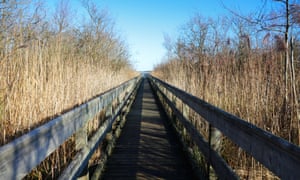
Norfolk’s tourist mecca is now its north coast but it was once the Broads. This maze of 125 miles of navigable waterways were a fashionable Edwardian playground enjoyed by everyone from Arthur Ransome to George Formby. Since then, this biodiversity hotspot has been associated with boozy motorboating holidays. And yet the Broads remain, as naturalist Ted Ellis wrote, “a breathing space for the cure of souls”. My favourite soul-cure is Barton Broad Boardwalk, a wheelchair-accessible path which dives into a mysterious British rainforest. Oaks and alder entwine with honeysuckle, all sprouting from a swamp. The path twists, woodpeckers drum, kingfishers flit. Suddenly, miraculously, a great freshwater lake hoves into view. Look out for otters and marsh harrier, the magnificent reedbed raptor that’s rarer than a golden eagle.
Patrick Barkham, Guardian writer and author of Islander (Granta, £20)
Digbeth, Birmingham
Scratch beneath Digbeth’s surface and you’ll be pleasantly surprised – I was. By repurposing dilapidated warehouses into vibrant venues, galleries, eateries and offices, this former industrial heartland just south of the city centre is now more colourful than grey. The mix of industrial heritage and innovation is alive and well at the Custard Factory (Bird’s produced their egg-free powdered custard here in the early 1900s), home of indie cinema the Mockingbird and Ghetto Golf, which offers cocktails and an 18-hole mini golf experience. Round the corner is the Clean Kilo, “the UK’s largest zero-waste supermarket”; the Night Owl on Lower Trinity Street is my favourite club in the country; and its neighbour, Digbeth Dining Club, offers street food aplenty. This neighbourhood never fails to enamour.
Richard Franks, founder-editor, Birmingham-based Counteract website
Swimming in Sussex
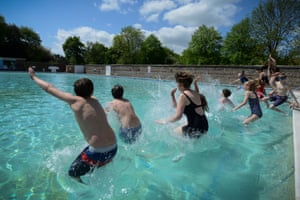
Those seeking a break from city living in the south often end up on the Sussex coast. Seaford gets overlooked by those heading to the beaches of Brighton or Eastbourne, but that’s OK – it means I have the beach to myself. In high swell the sea here can suck you in and spit you out, but that is part of the appeal. Visit on the right tide at sunrise or sunset and it is spectacular. If I start my day in Seaford, I can head inland and get to Pells Pool in Lewes before lunch. The UK’s oldest freshwater pool makes swimming lengths joyful and Lewes, like Seaford, has independent foodie delights, so I pick up a picnic before heading a few miles north to Barcombe to finish my day with a River Ouse swim at dusk.
Ella Foote, contributing editor, Outdoor Swimmer
Orford Castle, Suffolk
Like many fascinated by the past, I’m drawn to castles, a love I trace back to my first visit to Orford over 20 years ago. Stepping into one of the castle’s unlit chambers, I was confronted with a swarthy, naked man – half Robinson Crusoe, half fish. Of course it was only a wax dummy, but the story of the Orford merman, netted in the 12th century by local fishermen and kept prisoner in the castle, has stayed with me and come to define the eeriness of the Suffolk coast. The castle top offers magnificent views across Orford Ness. The “ness” is the long, shingle spit of land bisected by the River Ore, nosing out into the North Sea. Once a top-secret military site where atomic bombs were tested, it adds another layer of myth and mystery to this haunted landscape.

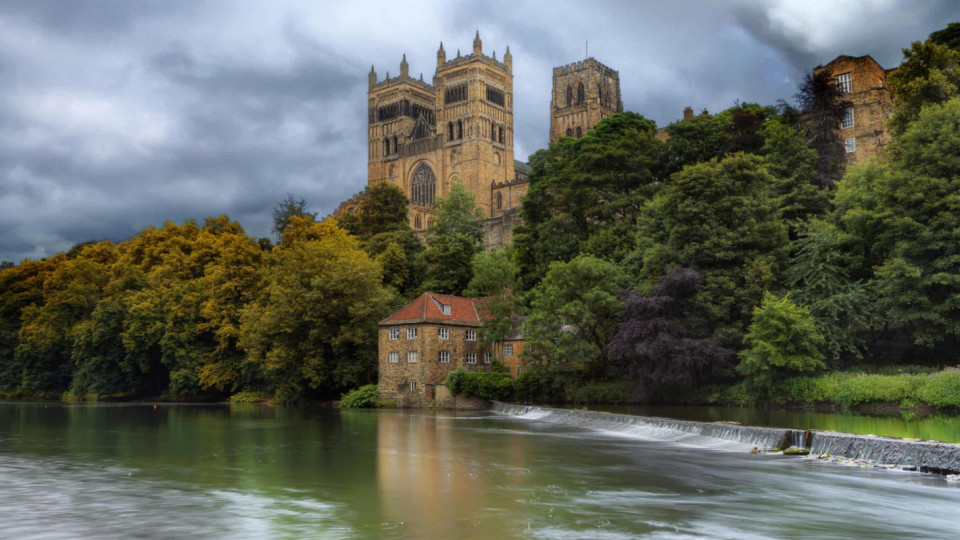
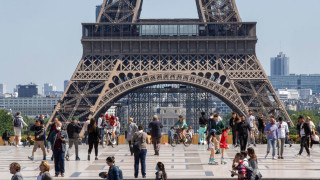








Leave a comment